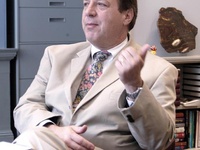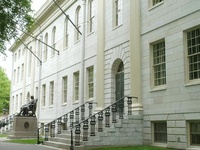The document made 45 specific recommendations for reforms, ranging in subject from advising to public service.
The report listed three possible options for the structure of the office of the dean of Harvard College. One model, the “single-faculty-dean structure,” called for the combination of the responsibilities of the dean of the College and the dean of undergraduate education, thus foreshadowing the consolidated deanship that Gross now stands poised to assume.
Knowles, known for his imperious leadership style, chose not to implement the report’s suggestion for a more powerful dean of the College.
“I chose a slightly different approach to invite a professor to be dean of the College, and so to have the benefit of two faculty colleagues supporting the undergraduate experience,” Knowles says.
“Personalities are definitely important,” says William M. Todd III, who served as dean of undergraduate education from 1997 to 2000 and who now heads the Department of Comparative Literature. “Knowles came from Oxford, where administration is minimal, conducted by people with very strong personalities, willing to work.”
Some have been left wondering why, 10 years after the changes proposed in the Lewis-Maull report were vetoed by Knowles, restructuring was such an urgent priority this spring.
In a speech delivered at a recent party thrown by Lewis’ staffers, Plummer Professor of Christian Morals Peter Gomes took several jabs at Kirby and Summers. Gomes recalled a time when Harvard’s management “worried about the structure first, and what came next later.”
Gomes suggests that ousting Lewis had been given priority above fleshing out how the administration would actually function under the new system. According to Gomes, the game plan had been to implement changes to get rid of the dean first and worry later about the logistics of these changes.
Gomes offers a hypothesis to a chicken-and-egg question that Summers and Kirby alone might be able to answer—which came first: the decision to get rid of Lewis or the move to restructure the deanships?
The Architect
Lewis has the original sketch of a Crimson editorial cartoon framed in his office. The cartoon depicts Summers pulling the strings of a puppet Kirby, who is kicking Lewis over.
The end of mild-mannered Neil L. Rudenstine’s ten-year University presidency in 2001 ushered in Summers and his top-down brand of management.
In his first two years in office, Summers has sought to tighten his managerial grip on the University’s different schools, particularly the College.
“From his first day, Larry has been most concerned about the College,” Knowles says.
With this acute interest, Summers has sought to exert influence on a range of College matters, from throwing his weight behind an initiative last year to offer more for-credit study abroad opportunities, to warning against what he feels is too great an emphasis on extracurriculars.
Read more in News
Pataki: 'Yale is Going to Crush Harvard'















